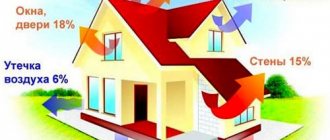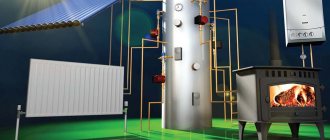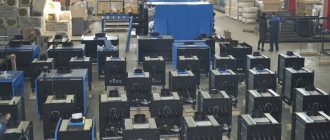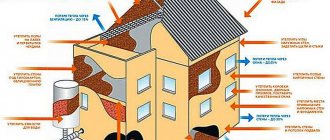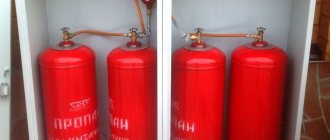Calculator for calculating the required thermal power for space heating
Explanations for calculations
We sequentially enter the data into the fields of the calculator.
First of all, we will determine the climatic features - indicating the approximate minimum temperature characteristic of the region of residence in the coldest decade of winter. Naturally, we are talking about normal temperatures for the region, and not about some “records” in one direction or another.
By the way, of course, this field will not change when calculating for all rooms of the house. In other fields, variations are possible.
Next comes a group of two fields, which indicate the area of the room (exactly) and the height of the ceilings (select from the list).
The following group of data takes into account the location of the room:
— The number of external walls, that is, those in contact with the street (selection from the list, from 0 to 3).
— The location of the external wall relative to the cardinal direction. There are walls that regularly receive a charge of thermal energy from the sun's rays. But the northern wall, for example, never sees the sun at all.
- If in the area where the house is located, there is a predominance of a certain direction of the winter wind (stable wind rose), then this can also be taken into account. That is, indicate whether the external wall is on the windward, leeward or parallel side to the wind direction
If there is no such data, then we leave it by default, and the program will calculate as for the most unfavorable conditions.
— Next, it is indicated how insulated the walls are. Select from three proposed options. More precisely, even of the two, since in a house with generally uninsulated walls, starting heating is absolute nonsense.
- Two similar fields of piglets indicate what the room is adjacent to “vertically”, that is, what is located above and below. This will help to estimate the size of heat loss through floors and ceilings.
The next group concerns indoor windows
What is important here is their number, size, and type, including the features of double-glazed windows. Based on the totality of this data, the program will develop a correction factor to the calculation result. Finally, the amount of heat loss is seriously affected by the presence in the room of doors facing the street, onto the balcony, into a cold entrance, etc.
If the doors are used regularly throughout the day, then any opening of them is accompanied by an influx of cold air. It is clear that this requires compensation in the form of additional thermal power.
All data has been entered - you can press the button. As a result, the user will immediately receive the desired value of thermal power for a specific room.
As already mentioned, the sum of all values will give the result for the entire house (apartment) as a whole, in kilowatts.
By the way, the heating boiler is also selected based on this value, considering it the minimum. And it is this total value that will be needed when the time comes to calculate the real cash costs of operating the heating system.
And the data for each room is also very useful - for selecting and arranging heating radiators, or for choosing the appropriate model of electric heater.
Heat energy payment standards
Standards for the consumption of utilities, for example water supply or heating, are considered a relatively constant value. Tariffs are approved by authorized bodies or resource supply organizations and cannot be changed for three years. But, despite this, the company that supplies the city with heat submits documents to local organizations justifying the increase in tariffs. After this, a meeting of the city council takes place, where a decision is made to accept or reject the new prices.
If the organization agrees to an increase in tariffs, then the consumed heat energy is recalculated and new tariffs are approved.
How to determine whether the correct amount of heat is entering your apartment? The calculation is based on the climatic conditions of the region, the material of the roof and walls, the type of house, as well as the wear and tear of utility networks, etc. The result is the amount of heat energy that is spent on heating 1 sq.m. living space in the house. This number is the standard. The unit of measurement of thermal energy is Gcal/sq.m - gigacalorie per square meter.
The main parameter when calculating heat is the average ambient temperature in winter. If the winter temperatures were not too low, the heating bill will be small. But, based on practice, this rarely happens.
Other ways to determine the amount of heat
Let us add that there are also other methods by which you can calculate the amount of heat that enters the heating system. In this case, the formula is not only slightly different from those given below, but also has several variations.
As for the values of the variables, they are the same as in the previous paragraph of this article. Based on all this, we can confidently conclude that it is quite possible to calculate the heat for heating on your own. However, one should not forget about consulting with specialized organizations that are responsible for providing housing with heat, since their methods and principles of calculations may differ, significantly, and the procedure may consist of a different set of measures.
If you intend to equip a “warm floor” system, then prepare for the fact that the calculation process will be more complex, since it takes into account not only the characteristics of the heating circuit, but also the characteristics of the electrical network, which, in fact, will heat the floor. Moreover, the organizations that install this kind of equipment will also be different.
Note! People often encounter the problem of converting calories into kilowatts, which is explained by the use of a unit of measurement in many specialized manuals, which is called “C” in the international system. >. In such cases, it is necessary to remember that the coefficient due to which kilocalories will be converted to kilowatts is 850
In simpler terms, one kilowatt is 850 kilocalories. This calculation option is simpler than those given above, since the value in gigacalories can be determined in a few seconds, since a Gcal, as noted earlier, is a million calories
In such cases, it is necessary to remember that the coefficient due to which kilocalories will be converted into kilowatts is equal to 850. In simpler terms, one kilowatt is 850 kilocalories. This calculation option is simpler than those given above, since the value in gigacalories can be determined in a few seconds, since a Gcal, as noted earlier, is a million calories.
In order to avoid possible mistakes, we should not forget that almost all modern heat meters operate with some error, albeit within acceptable limits. This error can also be calculated by hand, for which you need to use the following formula:
Traditionally, now we find out what each of these variable values means.
1. V1 is the flow rate of the working fluid in the supply pipeline.
2. V2 – a similar indicator, but in the return pipeline.
3. 100 is the number by which the value is converted to a percentage.
4. Finally, E is the error of the accounting device.
According to operational requirements and standards, the maximum permissible error should not exceed 2 percent, although in most meters it is somewhere around 1 percent.
As a result, we note that a correctly calculated Gcal for heating can significantly save money spent on heating the room. At first glance, this procedure is quite complicated, but - and you have seen this personally - if you have good instructions, there is nothing difficult about it.
That's all. We also recommend watching the thematic video below. Good luck in your work and, as usual, have a warm winter!
Heating systems
Heat supply is a system for supplying heat to buildings to maintain comfortable indoor temperatures during the cold season. The heat supply system consists of the following components: an enterprise that produces heat (boiler house, power plant); pipelines for transporting thermal energy (heating networks); heat consumers (radiators installed in premises).
Heat supply systems can be classified as follows:
- by heat source (centralized, decentralized);
- by the method of connection to the heat supply system (dependent, independent);
- according to the method of supplying water to hot water supply (DHW) (open, closed);
- by mode of consumption (seasonal, year-round);
- by the number of pipelines (single-pipe, multi-pipe);
- by the method of providing consumers with thermal energy (single-stage, multi-stage);
- by the method of regulating heat supply (centralized qualitative, local quantitative).
Centralized and decentralized types of heat supply:
In centralized systems, one source of thermal energy supplies several buildings. In a decentralized system, each building or group of houses, individual rooms generate heat independently. The classification of decentralized types of heat supply divides them into individual, when each apartment is heated independently, and local, where the heat source heats the entire apartment building.
Dependent and independent heat supply systems:
TERMS Dependent connection diagram for a heat-consuming installation is a diagram for connecting a heat-consuming installation to a heating network, in which the coolant from the heating network flows directly into the heat-consuming installation. An independent connection diagram for a heat-consuming installation is a diagram for connecting a heat-consuming installation to a heating network, in which the coolant coming from the heating network passes through a heat exchanger installed at a heating point, where it heats the secondary coolant, which is subsequently used in the heat-consuming installation.
As a rule, in all heat-consuming installations used for ventilation and air conditioning needs, in addition to heating and hot water systems, a secondary coolant is used that passes through the second circuit of the heat exchanger, that is, these heat-consuming installations always operate according to an independent connection scheme to the heating network. Therefore, it would be more correct to speak, as is customary in heat supply, not about an open (closed), dependent (independent) heat supply system, but about an open (closed) hot water supply system and a dependent (independent) heating system. By the way, the new rules are talking about just such systems - this can be seen from the placement of measurement points when taking into account the amount of thermal energy and coolant.
Closed and open heat supply systems
TERM Closed water heating system is a complex of technologically interconnected engineering structures designed for heat supply without extracting hot water (coolant) from the heating network.
Advantages of a closed scheme:
- for hot water supply, clean tap water is connected, in contrast to an open circuit, which meets all sanitary and hygienic standards without impurities and unpleasant odors;
- there is no need to install additional pumps and automatic parameter control devices at heat supply enterprises, since the pressure in the heating network is constant and does not depend on hot water consumption;
- at boiler houses and other heat supply sources there is no need to install additional water treatment units, because the circulating liquid is already desalted and contains a minimum amount of impurities;
- The energy-saving effect is achieved by adjusting the required heat supply temperature at heating points, performed automatically.
Disadvantages of a closed scheme:
- To set up energy exchange points where the heating temperature of tap water is regulated, expensive equipment and automation are needed;
- high temperatures of coolants in main heating mains lead to high heat losses. This drawback has now lost its relevance due to the use of polyurethane foam pipe thermal insulation technology, which ensures the strength of the insulating coating and effective protection against heat loss.
To reduce the cost of a closed heat supply system, a central heating point (CHS) is installed for several houses or a microdistrict. The central heating station is a room with heat exchangers, pumps and automatic devices for regulating the water supply. Water supply pipelines and heating networks are connected to the central heating station.
Tap water passes through heat exchangers and, when heated, is supplied to a circular hot water supply system, where it circulates along the circuit and is consumed by consumers as needed.
IMPORTANT ! The use of central heating stations allows you to save costs on the construction of heating points.
Consolidation of a heat exchange installation over several blocks or a microdistrict reduces the cost of purchasing and installing equipment and automation compared to installing a heating point in each house.
TERM Open water heating system is a complex of technologically interconnected engineering structures designed for heat supply and (or) hot water supply by extracting hot water (coolant) from the heating network or extracting hot water from hot water supply networks.
From the definition of an open system it follows that in this system the mass of the coolant is not constant and the coolant can be spent both for the needs of hot water supply and for other technological needs. However, it is not clear what these other needs are. If the heat supply system operates in normal mode, then the coolant is consumed only for the needs of the hot water supply, and if the system operates in abnormal mode (unauthorized water withdrawal, leakage of coolant through leaks in shut-off and control valves and pipelines), then in this case, in addition to productive losses of coolant in DHW needs, there are also unproductive losses of coolant due to unauthorized leaks.
Therefore, it would be better to talk about productive (for the needs of hot water supply) losses and unproductive (leakage) losses.
Advantages of the open type of coolant supply:
- minimum equipment, since the use of heat exchangers is not required;
- due to the fact that the water temperature is lower, losses during transportation along heating mains over long distances are less than in a closed system.
Disadvantages of an open scheme:
- Dirty water. Due to the large length of the heating main, the liquid entering the hot water supply pipelines contains a large amount of dirt and rust, which it collects along the way from the boiler room to the consumer. Due to the large length of heating pipelines, the water in the tap may have an unpleasant odor and color and may not meet sanitary standards. Installing water treatment devices in each home will require significant financial costs.
- The high demand for hot water during peak hours leads to a noticeable drop in pressure in the pipelines. Because of this, it forces resource supply companies to install additional booster pumps and automation to control the pressure in the system. Otherwise, the pressure drop will lead to less coolant passing through the heaters in apartments, and as a result, a decrease in the air temperature in the rooms. High losses of liquid from the thermal system force boiler houses, thermal power plants and other energy-producing enterprises to install massive water treatment plants that purify river water from salts and other impurities.
Calculation formula
Thermal energy consumption standards
Thermal loads are calculated taking into account the power of the heating unit and the heat losses of the building. Therefore, in order to determine the power of the designed boiler, it is necessary to multiply the heat loss of the building by an increasing factor of 1.2. This is a kind of reserve equal to 20%.
Why is such a coefficient necessary? With it you can:
- Predict the drop in gas pressure in the pipeline. After all, in winter there are more consumers, and everyone tries to take more fuel than others.
- Vary the temperature inside the house.
Let us add that heat losses cannot be distributed evenly throughout the entire building structure. The difference in indicators can be quite large. Here are some examples:
- Up to 40% of the heat leaves the building through the external walls.
- Through floors - up to 10%.
- The same applies to the roof.
- Through the ventilation system - up to 20%.
- Through doors and windows - 10%.
So, we sorted out the design of the building and made one very important conclusion: the heat losses that need to be compensated depend on the architecture of the house itself and its location. But much is also determined by the materials of the walls, roof and floor, as well as the presence or absence of thermal insulation
This is an important factor.
For example, let’s determine the coefficients that reduce heat loss, depending on window structures:
- Ordinary wooden windows with ordinary glass. To calculate thermal energy in this case, a coefficient of 1.27 is used. That is, through this type of glazing there is a leakage of thermal energy equal to 27% of the total.
- If plastic windows with double-glazed windows are installed, then a coefficient of 1.0 is used.
- If plastic windows are installed from a six-chamber profile and with a three-chamber double-glazed window, then a coefficient of 0.85 is taken.
Let's move on, dealing with the windows. There is a certain relationship between the area of the room and the area of window glazing. The larger the second position, the higher the heat loss of the building. And there is a certain relationship here:
- If the window area in relation to the floor area has only a 10% indicator, then a coefficient of 0.8 is used to calculate the thermal power of the heating system.
- If the ratio is in the range of 10-19%, then a coefficient of 0.9 is applied.
- At 20% - 1.0.
- At 30% -2.
- At 40% - 1.4.
- At 50% - 1.5.
And these are just the windows. And there is also the influence of the materials used in the construction of the house on thermal loads. Let's arrange them in the table, where wall materials will be located with a decrease in heat losses, which means their coefficient will also decrease:
Type of building material
As you can see, the difference from the materials used is significant. Therefore, even at the stage of designing a house, it is necessary to determine exactly what material it will be built from. Of course, many developers build a house based on the budget allocated for construction. But with such layouts it is worth reconsidering it. Experts assure that it is better to invest initially in order to later reap the benefits of savings from operating the house. Moreover, the heating system in winter is one of the main expense items.
Sizes of rooms and number of floors of the building
Heating system diagram
So, we continue to understand the coefficients that affect the heat calculation formula. How do room sizes affect thermal loads?
- If the ceiling height in your house does not exceed 2.5 meters, then the calculation takes into account a coefficient of 1.0.
- At a height of 3 m, 1.05 is already taken. It's a minor difference, but it has a significant impact on heat loss if the total area of the house is large enough.
- At 3.5 m - 1.1.
- At 4.5 m -2.
But such an indicator as the number of storeys of a building affects the heat loss of a room in different ways. Here it is necessary to take into account not only the number of floors, but also the location of the room, that is, on which floor it is located. For example, if this is a room on the first floor, and the house itself has three or four floors, then a coefficient of 0.82 is used for the calculation.
When moving a room to the upper floors, the rate of heat loss also increases. In addition, you will have to take into account the attic - whether it is insulated or not.
As you can see, in order to accurately calculate the heat loss of a building, it is necessary to determine various factors. And they all must be taken into account. By the way, we have not considered all factors that reduce or increase heat losses. But the calculation formula itself will mainly depend on the area of the heated house and on an indicator called the specific value of heat loss. By the way, in this formula it is standard and equal to 100 W/m². All other components of the formula are coefficients.
Normalized parameters
They are contained in the appendices to SNiP 02/23/2003, tab. 8 and 9. Here are excerpts from the tables.
For single-family, one-story detached houses
| Heated area | Specific heat consumption, kJ/(m2*S*day) |
| Up to 60 | 140 |
| 100 | 125 |
| 150 | 110 |
| 250 | 100 |
For apartment buildings, dormitories and hotels
| Number of storeys | Specific heat consumption, kJ/(m2*S*day) |
| 1 — 3 | According to the table for single-family houses |
| 4 — 5 | 85 |
| 6 — 7 | 80 |
| 8 — 9 | 76 |
| 10 — 11 | 72 |
| 12 and above | 70 |
Please note: as the number of floors increases, the heat consumption rate decreases. The reason is simple and obvious: the larger an object of a simple geometric shape, the greater the ratio of its volume to surface area. For the same reason, the specific heating costs of a country house decrease with an increase in the heated area.
Heating a unit of area in a large house is cheaper than heating a small one.
Easy ways to calculate heat load
Any calculation of the thermal load is needed to optimize the parameters of the heating system or improve the thermal insulation characteristics of the house. After its implementation, certain methods of regulating the heating heat load are selected. Let's consider non-labor-intensive methods for calculating this parameter of the heating system.
Dependence of heating power on area
Table of correction factors for various climatic zones of Russia
For a house with standard room sizes, ceiling heights and good thermal insulation, you can apply a known ratio of room area to the required heating power. In this case, 1 kW of heat will need to be generated per 10 m². A correction factor must be applied to the result obtained, depending on the climate zone.
Let's assume that the house is located in the Moscow region. Its total area is 150 m². In this case, the hourly heating load will be equal to:
The main disadvantage of this method is the large error. The calculation does not take into account changes in weather factors, as well as the features of the building - the heat transfer resistance of walls and windows. Therefore, in practice it is not recommended to use it.
Integrated calculation of the thermal load of a building
A larger calculation of the heating load is characterized by more accurate results. Initially, it was used for preliminary calculation of this parameter when it was impossible to determine the exact characteristics of the building. The general formula for determining the heating load is presented below:
Where q° is the specific thermal characteristic of the structure. The values must be taken from the corresponding table, a is the correction factor mentioned above, Vn is the external volume of the building, m³, Tin and Tnro are the temperature values inside the house and outside.
Table of specific thermal characteristics of buildings
Let's assume that it is necessary to calculate the maximum hourly heating load in a house with a volume along the external walls of 480 m³ (area 160 m², two-story house). In this case, the thermal characteristic will be equal to 0.49 W/m³*C. Correction factor a = 1 (for the Moscow region). The optimal temperature inside the living space (Tvn) should be +22°C. The outside temperature will be -15°C. Let's use the formula to calculate the hourly heating load:
Compared to the previous calculation, the resulting value is smaller. However, it takes into account important factors - temperature indoors, outdoors, and the total volume of the building. Similar calculations can be made for each room. The method for calculating the heating load using aggregate indicators makes it possible to determine the optimal power for each radiator in a separate room. For a more accurate calculation, you need to know the average temperature values for a specific region.
This calculation method can be used to calculate the hourly heat load for heating. But the results obtained will not provide an optimally accurate value of the building’s heat losses.
Energy
How to calculate energy costs with your own hands, knowing the heat consumption?
It is enough to know the calorific value of the corresponding fuel.
The easiest way is to calculate the energy consumption for heating a house: it is exactly equal to the amount of heat produced by direct heating.
An electric boiler converts all consumed electricity into heat.
Thus, the average power of an electric heating boiler in the last case we considered will be equal to 4.33 kilowatts. If the price of a kilowatt-hour of heat is 3.6 rubles, then we will spend 4.33*3.6=15.6 rubles per hour, 15*6*24=374 rubles per day, and so on.
It is useful for owners of solid fuel boilers to know that firewood consumption rates for heating are about 0.4 kg/kWh. Coal consumption rates for heating are half as much - 0.2 kg/kWh.
Coal has a fairly high calorific value.
Thus, in order to calculate the average hourly consumption of firewood with your own hands at an average heating power of 4.33 kW, it is enough to multiply 4.33 by 0.4: 4.33 * 0.4 = 1.732 kg. The same instructions apply to other coolants - just look in the reference books.
How to calculate the consumed thermal energy?
If for one reason or another there is no heat meter, then to calculate thermal energy you must use the following formula:
Vx(T1-T2)/1000=Q
Let's look at what these symbols mean.
1. V denotes the amount of hot water consumed, which can be calculated either in cubic meters or in tons.
2. T1 is the temperature indicator of the hottest water (traditionally measured in the usual degrees Celsius). In this case, it is preferable to use exactly the temperature that is observed at a certain operating pressure. By the way, the indicator even has a special name - enthalpy. But if the required sensor is missing, then as a basis you can take the temperature regime that is extremely close to this enthalpy. In most cases, the average is approximately 60-65 degrees.
3. T2 in the above formula also denotes the temperature, but of cold water. Due to the fact that it is quite difficult to penetrate the main line with cold water, constant values are used as this value, which can change depending on the climatic conditions outside. So, in winter, when the heating season is in full swing, this figure is 5 degrees, and in the summer, when the heating is turned off, 15 degrees.
4. As for 1000, this is the standard coefficient used in the formula in order to obtain the result in gigacalories. It will be more accurate than if you used calories.
5. Finally, Q is the total amount of thermal energy.
As you can see, there is nothing complicated here, so we move on. If the heating circuit is of a closed type (and this is more convenient from an operational point of view), then the calculations must be made slightly differently. The formula that should be used for a building with a closed heating system should look like this:
((V1x(T1-T)-(V2x(T2-T))=Q
Now, accordingly, to the decoding.
1. V1 indicates the flow rate of the working fluid in the supply pipeline (typically, not only water, but also steam can act as a source of thermal energy).
2. V2 is the flow rate of the working fluid in the return pipeline.
3. T is an indicator of the temperature of a cold liquid.
4. T1 – water temperature in the supply pipeline.
5. T2 – temperature indicator that is observed at the outlet.
6. And finally, Q is the same amount of thermal energy.
It is also worth noting that the calculation of Gcal for heating in this case depends on several notations:
- thermal energy that entered the system (measured in calories);
- temperature indicator during the removal of working fluid through the return pipeline.
Comfortable room temperature
Comfortable temperature indicators are regulated by the state. In Russia, standards are prescribed for all regions.
Standards for temperature parameters are contained in the document GOST 30.494 - 2011 and include indicators depending on the type of room:
- in the rooms a comfortable temperature is considered to be +20 - +22°C;
- in the kitchen - +19 - +21°C;
- in the bathroom - +24 - +26°C;
- in the toilet - +19 - +21°С;
- in the hallway - +18 - +20°C.
If the temperature does not reach these values, the heating norm for 1 m2 of the house is not met, you can complain and demand a recalculation of the energy consumed.
The standards take into account the purpose of the premises. The bedroom should be ventilated, after which it should be at a normal temperature. In children, the temperature at the upper limit is considered normal, and as the child grows older, it moves to the lower limit. In the bathroom, the increased rate is due to dampness, which makes you feel dank.
Coolant in the heating system: calculation of volume, flow rate, injection and more
In order to have an idea about the proper heating of an individual home, you should understand the basic concepts. Let's consider the processes of coolant circulation in heating systems. You will learn how to properly organize the circulation of coolant in the system. It is recommended that you watch the explanatory video below for a more in-depth and thoughtful presentation of the subject of study.
Calculation of coolant in the heating system ↑
The volume of coolant in heating systems requires accurate calculation.
Calculation of the required volume of coolant in a heating system is most often done at the time of replacement or reconstruction of the entire system. The simplest method would be to simply use the appropriate calculation tables. They are easy to find in thematic directories. According to the basic information contains:
- in the aluminum radiator (battery) section there is 0.45 liters of coolant;
- in the cast iron radiator section 1/1.75 liters;
- linear meter of 15 mm/32 mm pipe 0.177/0.8 liters.
Calculations are also necessary when installing the so-called feed pumps and expansion tank. In this case, to determine the total volume of the entire system, it is necessary to add up the total volume of heating devices (batteries, radiators), as well as the boiler and pipelines. The calculation formula is:
V = (VS x E)/d, where d is an indicator of the efficiency of the installed expansion tank; E represents the expansion coefficient of the liquid (expressed as a percentage), VS is equal to the volume of the system, including all elements: heat exchangers, boiler, pipes, and radiators; V is the volume of the expansion tank.
Regarding the expansion coefficient of the liquid. This indicator can have two values, depending on the type of system. If the coolant is water, its value for calculation is 4%. In the case of, for example, ethylene glycol, the expansion coefficient is taken to be 4.4%.
An in-depth assessment of the volume of heating devices, including the boiler and pipelines, is not necessary. Let's look at this with a specific example. For example, the power of the heating system of a particular house was 75 kW.
In this case, the total volume of the system is derived from the formula: VS = 75 x 15 and will be equal to 1125 liters.
It should also be taken into account that the use of various kinds of additional elements of the heating system (whether pipes or radiators) one way or another reduces the total volume of the system. Comprehensive information on this issue can be found in the relevant technical documentation of the manufacturer of certain elements.
Injecting coolant into the heating system ↑
Having decided on the system volume indicators, you should understand the main thing: how the coolant is pumped into a closed-type heating system.
There may be two options:
- download so-called “gravity flow” - when filling is carried out from the highest point of the system. At the same moment, at the lowest point, you should open the drain valve - it will be visible when liquid begins to flow into it;
- forced injection with a pump - any small pump, like those used for low-lying summer cottages, is suitable for this purpose.
During the injection process, you should monitor the pressure gauge readings, not forgetting that the air vents on heating radiators (batteries) must be open.
Coolant flow in the heating system ↑
The flow rate in the coolant system implies the mass amount of coolant (kg/s) intended to supply the required amount of heat to the heated room.
The calculation of the coolant in the heating system is determined as the quotient of dividing the calculated heat demand (W) of the room (rooms) by the heat transfer of 1 kg of heating fluid (J/kg).
The coolant flow in the system during the heating season in vertical central heating systems changes, since they are regulated (especially with regard to the gravitational circulation of the coolant. In practice, in calculations, the coolant flow is usually measured in kg/h.
Efficiency of heat supply systems
To assess the efficiency of the heat supply system, a generalized physical indicator is used - efficiency factor (efficiency factor). The physical meaning of efficiency is the ratio of the amount of useful work (energy) received to the amount expended. The latter, in turn, is the sum of the useful work (energy) received and losses arising in system processes. Thus, increasing the efficiency of the system, and therefore increasing its efficiency, can only be achieved by reducing the amount of unproductive losses that arise during operation.
ATTENTION ! Reducing the amount of unproductive losses is the main task of energy saving.
The main problem that arises when solving this problem is identifying the largest components of these losses and choosing the optimal technological solution that can significantly reduce their impact on the efficiency value. Whenever it comes to improving the efficiency of thermal power equipment (for example, a heating system), before deciding to use any technological innovation, it is imperative to conduct a detailed examination of the system itself and identify the most significant sources of energy loss. A reasonable solution would be to use only technologies that will significantly reduce the largest unproductive components of energy loss in the system and, at minimal cost, significantly increase its operating efficiency.
Let's consider the most typical problems of existing thermal facilities, the most significant sources of unproductive losses of thermal energy in them.
Sources of losses in heat supply systems
As mentioned above, for the purpose of analysis, any heat and power system can be divided into 3 main sections. Each of the above sections has characteristic unproductive losses, the reduction of which is the main function of energy saving. Let's look at each section separately.
Thermal energy production area (boiler room)
In the thermal energy production area, during normal operation of the boiler unit, there are always three types of main losses: with underburning of fuel and exhaust gases (usually no more than 18%), energy losses due to the lining of the boiler (no more than 4%); losses with blowing and for the boiler house’s own needs (about 3%). These heat loss figures are approximately close for a normal, non-new domestic boiler (with an efficiency of about 75%). More advanced modern boiler units have a real efficiency of about 80–85% and these standard losses are lower.
Section of thermal energy transportation to the consumer (heating network pipelines)
Typically, the thermal energy transferred to the coolant in the boiler room enters the heating main and goes to consumer facilities. The efficiency value of a given section is usually determined by the following:
- Efficiency of network pumps that ensure the movement of coolant along the heating main;
- losses of thermal energy along the length of heating mains associated with the method of laying and insulating pipelines;
- losses of thermal energy associated with the correct distribution of heat between consumer objects, the so-called. hydraulic configuration of the heating main;
- periodically occurring coolant leaks during emergencies and emergencies.
Typically, thermal energy losses in heating mains should not exceed 5–7%. But in fact they can reach values of 25% or higher!
Thermal energy consumption area (heated facility)
The most significant components of heat losses in heat power systems are losses at consumer facilities. The presence of such can be determined only after the appearance of thermal energy metering devices, the so-called, in the heating station of the building. heat meter. By installing thermal energy metering devices at the facility, you can understand the overall picture of heat consumption, analyze the current situation and choose the most effective way to use thermal energy. The main sources of unproductive losses of thermal energy at facilities:
- associated with uneven heat distribution in heating systems throughout the facility and irrationality of the facility’s internal thermal circuit (5–15%);
- associated with a discrepancy between the nature of heating and current weather conditions (15–20%);
- due to the lack of hot water recirculation in hot water systems, up to 25% of thermal energy is lost;
- due to the absence or inoperability of hot water regulators on boilers in DHW systems (up to 15% of the DHW load);
- in tubular (high-speed) boilers due to the presence of internal leaks, contamination of heat exchange surfaces and difficulty of regulation (up to 10–15% of the DHW load).
When operating heat supply systems, the technical service of the enterprise needs to think through an algorithm of actions that will minimize the loss of thermal energy in the area of operational responsibility. For these purposes, an “Action Plan to reduce energy consumption and introduce effective energy-saving measures” is being developed.
EXAMPLE Employees of an enterprise constantly complained about uncomfortable working conditions (low temperature) in the office premises during the cold season. Temperature conditions greatly influence the well-being and performance of people. Low air temperature, which affects an employee for a long time, not only has a negative impact on health, but also sharply reduces labor productivity. Office workers perform a wide variety of activities, most of which involve spending long periods of time in the same position, usually sitting and sedentary. During the cold season, a comfortable temperature indoors should be maintained at 22–24 °C. Fluctuations in the norm of up to 1–2 °C are acceptable, and for a short time during the working day the thermometer column can “jump” by 3–4 °C. What to do if the temperature in the office premises is significantly lower than comfortable values? The room where people felt this discomfort was no different from the neighboring ones. The first step is to understand why this is happening, and to do this you need to conduct a thermal audit. Conducting a thermal audit is one of the most effective ways to optimize a building’s energy costs. After analyzing the data obtained after conducting a thermal audit, it turned out that the thermal insulation of the ceiling in this room had become unusable. Heat from the room entered the attic, the temperature of the roof increased, which contributed to the intensive melting of the snow lying on it and the formation of icicles. After the thermal insulation was restored, the temperature in the office became comfortable, and icicles stopped appearing on this section of the roof. Total implicit non-productive losses at a consumption facility can amount to up to 35% of the heat load!
IMPORTANT ! Conclusions : 1. Reducing the amount of unproductive losses is the main task of energy saving. 2. Each section of the heat supply system has characteristic unproductive losses. 3. The technical service of the enterprise needs to think through an algorithm of actions that will minimize thermal energy losses.
The cost of heating services per 1 sq. m in Gcal in 2022 in an apartment building
Heating charges vary from region to region. The maximum indicators (which, of course, are in demand) are set by the regional administration, as a rule, for every six months. Plus, the formulation “heating price per 1 kW per m²” is not correct - government authorities limit the cost of the gigacalorie itself consumed by a utility unit.
After all, a gigacalorie is an analogue of a unit of work (the same Joule or kilowatt-hour), simply having a larger scale for convenience. For example:
- 1 gigacalorie corresponds to 4,184,000,000.00 Joules (4.184 gJ);
- 1 gigacalorie corresponds to 1,162.22 kilowatt-hours (kWh).
It is convenient to account for heat in gigacalories due to the large scale of thermal energy consumption (heat has an extremely high energy density compared, for example, with the same mechanical work).
These standards vary greatly among different regions due to the fact that temperature climatic regimes also differ significantly between them (winter in the Stavropol region is one thing and quite another in Anadyr). In addition, even within the same region (subject of the Federation) there may be several types of standards, depending on the quality of the house for which this standard is applied.
If this is a wooden barracks built in the 50s of the last century, then it will require more energy to maintain a comfortable temperature environment than in more modern multi-story buildings.
The standard is set specifically for 1 m² of living space, that is, there is a link: the larger your apartment, the more you will have to pay for heat if standard coefficients apply, regardless of how effective the thermal insulation is in your home.
Understanding this, the state administration seeks to create conditions and stimulate the process of equipping all consumers with individual heat meters, that is, at a minimum, to install communal heat meters.
However, there are a number of limitations:
- Now an individual metering device for an apartment (in houses built before 2012) is installed if there is a centralized supply from a single riser. If there are several pipes, then the installation of an IPU is considered physically impossible at this stage due to the need to install a large number of meters (for each battery), the high cost of the process and the complexity of accounting. Apartment buildings put into operation after 01/01/2012 (as a new building or after a major overhaul) are required by law to be equipped with individual and communal heat meters.
- Also, sometimes technical difficulties arise that make it impossible to install a common house metering device (CDMU).
In these cases, accounting is carried out in accordance with the standards. But if it is technically possible to install IPU and ODPU, and consumers still prefer to remain on the standard system of charging for heat supply, then penal increasing coefficients already begin to apply (you can learn how to decipher KPU, IPU and other abbreviations in the receipt for housing and communal services find out here).From 01/01/2017, this increasing coefficient is equal to 1.1 to the fee set by the heat supply organization. The very cost of 1 Gcal per 1 square meter in each region, of course, will be different.
Legislative documents: SNiP 41-01-2003, SP 41-108-2004 and others
The table shows a list of regulatory documents governing the requirements for the construction and quality control of heating systems, taking into account the latest changes as of 2022:
| Normative act | Date of introduction | A comment |
| SNiP 2.04.05-91 | 01.01.1992 | General requirements for ventilation, heating and air conditioning systems, canceled as of 01/01/2004. |
| SNiP 41-01-2003 | 01.01.2004 | Regulates the parameters of internal air, requirements for heating systems, heat supply, fittings, pipeline laying, features of the installation of stove heating, updated version of SNiP 2.04.05-91, not valid from 01/01/2013. |
| SP 60.13330.2012 | 01.01.2013 | Updated version of SNiP 41-01-2003. |
| SP 41-108-2004 | 01.01.2005 | Regulates the requirements for the selection and placement of heat generators, features of gas supply and disposal of combustion products, installation of electricity and heating in apartment buildings. |
| SanPiN 2.1.2.2645-10 | 10.06.2010 | Hygienic requirements for heating systems. |
| GOST R 56501-2015 | 01.03.2016 | Regulates the management of heat supply systems, the specifics of providing consumers with communal heating resources, requirements for quality control and repair maintenance. |
| GOST 30494-2011 | 01.03.2011 | Features of setting the temperature regime, quality control and measurement procedure. |
| SNiP 41-02-2003 | 01.09.2003 | Features of arrangement of heating networks, quality control. |
| SNiP 01/31/2003 | 01.10.2003 | Some requirements for the placement of heating systems in apartment buildings. |
| Government Decree No. 354 | 06.05.2011 | Features of the provision of utility services for heat supply. |
Thermal imaging inspection
Increasingly, in order to increase the efficiency of the heating system, they are resorting to thermal imaging inspections of the structure.
This work is carried out in the dark. For a more accurate result, you need to observe the temperature difference between indoors and outdoors: it should be at least 15 o. Fluorescent and incandescent lamps turn off. It is advisable to remove carpets and furniture as much as possible; they knock down the device, causing some error.
The survey is carried out slowly and data is recorded carefully. The scheme is simple.
The first stage of work takes place indoors
The device is moved gradually from doors to windows, paying special attention to corners and other joints
The second stage is an inspection of the external walls of the building with a thermal imager. The joints are still carefully examined, especially the connection with the roof.
The third stage is data processing. First, the device does this, then the readings are transferred to the computer, where the corresponding programs complete the processing and produce the result.
If the survey was carried out by a licensed organization, it will issue a report with mandatory recommendations based on the results of the work. If the work was carried out in person, then you need to rely on your knowledge and, possibly, the help of the Internet.
How to stay fit while on vacation: 14 tips from nutritionists Many of us are diligently preparing for the beach season. But, unfortunately, while enjoying a well-deserved vacation, it is so easy to lose your physical shape. However.
15 Cancer Symptoms Women Most Often Ignore Many signs of cancer are similar to symptoms of other diseases or conditions, which is why they are often ignored.
Pay attention to your body. If you notice
Top 10 Broke Stars It turns out that sometimes even the biggest fame ends in failure, as is the case with these celebrities.
Our ancestors slept differently than we do. What are we doing wrong? It’s hard to believe, but scientists and many historians are inclined to believe that modern man sleeps completely differently than his ancient ancestors. Initially.
Contrary to all stereotypes: a girl with a rare genetic disorder conquers the fashion world. This girl's name is Melanie Gaydos, and she burst into the fashion world quickly, shocking, inspiring and destroying stupid stereotypes.
7 Body Parts You Shouldn't Touch with Your Hands Think of your body as a temple: you can use it, but there are some sacred places that you shouldn't touch with your hands. Research showing.
How to control heat energy consumption?
If you have meters installed, then you can control the consumption of thermal energy. Thus, on a monthly basis you can independently monitor the amount of wasted heat that went into heating the apartment. Consumers can save significantly on utility bills. A significant difference is visible if control valves are installed on the radiators.
There are cases when, in cold weather, utility services do not control the temperature of the coolant and the batteries heat up more than necessary. In this case, the apartment is very hot and you have to open the windows to let out excess heat. In addition, you will have to pay for heat in full. There are other cases when the coolant temperature is lower than required. In this case, you have to feel uncomfortable in severe frosts.
Residents who have not installed heat meters do not have the desire to save on utility bills for heat energy. They see no point in insulating walls or windows.
If your apartment has an individual heat meter, you can independently regulate the temperature of the coolant and set a comfortable temperature in the apartment. In this case, residents are more careful about heat consumption. In addition, they are interested in insulating openings and walls. And you will have to pay much less for heat supply. To pay, you just need to take readings from the meter and multiply by the tariff.
